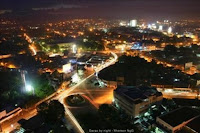The City of Butuan is the regional center of Caraga an administrative region of the Philippines. It is located at the northeastern part of Agusan Valley Mindanao, sprawling across the Agusan River. It is bounded to the north, west and south by Agusan del Norte, to the east by Agusan del Sur and to the northwest by Butuan Bay. According to the 2007 census, it has a population of 298,378 people.
The name "Butuan" is believed to have originated from the sour fruit "Batuan"(Garcinia morella). Other etymology sources say that it comes from a certain "Datu Buntuan", a chieftain who once ruled over Butuan.
 Butuan was the capital of Agusan del Norte until 2000 when Republic Act 8811 transferred the capital to Cabadbaran City. However many of the provincial government offices are still located there, including the provincial capitol, as are many the Caraga regional offices of the national government agencies.
Butuan was the capital of Agusan del Norte until 2000 when Republic Act 8811 transferred the capital to Cabadbaran City. However many of the provincial government offices are still located there, including the provincial capitol, as are many the Caraga regional offices of the national government agencies. The name "Butuan" is believed to have originated from the sour fruit "Batuan". Other etymology sources say that it comes from a certain "Datu Buntuan", a chieftain who once ruled over Butuan. The City of Butuan is the regional center of the Caraga Region in the Philippines. It lies flat along the banks of Agusan River following along course within the province of Davao del Norte, Agusan del Sur, Agusan del Norte and drains into Butuan Bay. Butuan serves a strategic center of the Northern Mindanao region. The fishing ground of Butuan is the Butuan Bay of which two coastal barangays are located. It extends some two kilometers to the sea and joins the Bohol Sea. These are barangays Lumbocan and Masao.
OFFICIAL DETAILS:
City Head:
City Population: 307,942 as of 2009
City Land Area: 817.28 km2
City Classification: Highly Urbanized City
AWARDS & CITATIONS:
MONIKER/NICKNAMES:
LINKS FOR MORE ABOUT THE CITY HERE:
@ http://butuantoday.tumblr.com/
@ http://www.butuancityguide.com/
MORE OF THE CITY’S PIC HERE:































